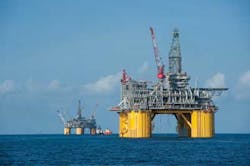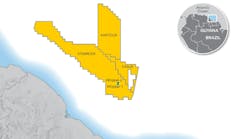Bruce Beaubouef
Managing Editor
Shell's Mars B project, located in the deepwater Gulf of Mexico, produced first oil in the first quarter of this year. It is the first time that significant infrastructure has been added to an existing deepwater field in the Gulf, says Shell.
Located in the Mississippi Canyon area in 3,000 ft (914 m) of water some 130 mi south of New Orleans, Mars B is the lone entrant from the GoM in this year'sTop 5 projects.
The original Mars field has been operating since 1996, producing roughly 700 MMboe to date. But the size of the opportunity in the development area made it economical to build and deploy a new, second TLP to the area. Shell estimates that there are 1 Bbbl left in the area.
TheMars B project will add new infrastructure to develop the Mars field and nearby exploration discoveries. This new infrastructure includes:
- TheOlympus TLP, with 24 well slots and a self-contained drilling rig
- The West Boreas/South Deimos subsea system
- An oil and gas export system, including a West Delta (WD)-143C shallow-water platform.
The key to the project has been theOlympus TLP, which is now moored about one mi (1.6 km) from the existing Mars platform. In another industry first, the 120,000-ton structure is said to be the largest TLP ever developed for the GoM.
Shell notes that theOlympus TLP is more than twice as "big" as the original Mars TLP. Weighing over 120,000 tons, the TLP is heavier than 300 Boeing 747 Jumbo Jets. From the base of the hull to the top of the derrick, Olympus is 406 ft tall, approximately 1.5 times the height of the Mercedes-Benz Superdome in New Orleans, which stands 253 ft in height.
The combined deck area on theOlympus is 342,000 sq ft, greater than the total floor area of the Mercedes-Benz Superdome, which is 269,000 sq ft. The column spacing on the TLP is 250 ft (center/center) – a similar footprint to One Shell Square in New Orleans. The tension legs of the platform are fitted with 16 rotationally lined caissons coated with modified high-density polyethylene.
The new TLP hosts a 24-slot drilling unit supplied by Nabors Industries and includes capacity for six subsea wells to gather production from the nearby West Boreas and South Diemos fields via tieback. The reservoirs are located at depths of 10,000 ft to 22,000 ft, approximately 2 to 4 mi below sea level.Olympus, outfitted with 15,000 psi-rated trees furnished by FMC Technologies, will concentrate on high-pressure reservoirs that range in depth from 20,000-22,000 ft.
The subsea production system includes:
- A 3-mi tieback to theOlympus TLP
- A six-well 15 kpsi subsea tieback
- A six-slot production manifold
- Dual 8-in. flowlines
- Flexibility to connect future subsea developments.
These facilities are expected to extend the life of the field to 2050 and beyond.
In developing Mars B and its other deepwater assets, Shell was able to draw upon a rich deepwater history that goes back to the Cognac development in 1978, and up to the existing Perdido facility, the current world record holder for deepwater operations.
Olympus is Shell's sixth and largest TLP in the GoM, and uses a passive hull concept that incorporates lessons learned from the Perdido spar, with regard to the shape of the column and placement.
Shell made use of time lapse seismic technology to delineate the Mars B field. This included use of ocean bottom sensor technology, including ocean bottom nodes and wide azimuth acquisition techniques. Use of these technologies, in turn, led to better placement of infield wells, and a better understanding of waterflood performance. This will help increase overall recovery.
Displaying 1/2 Page 1,2Next>
View Article as Single page






